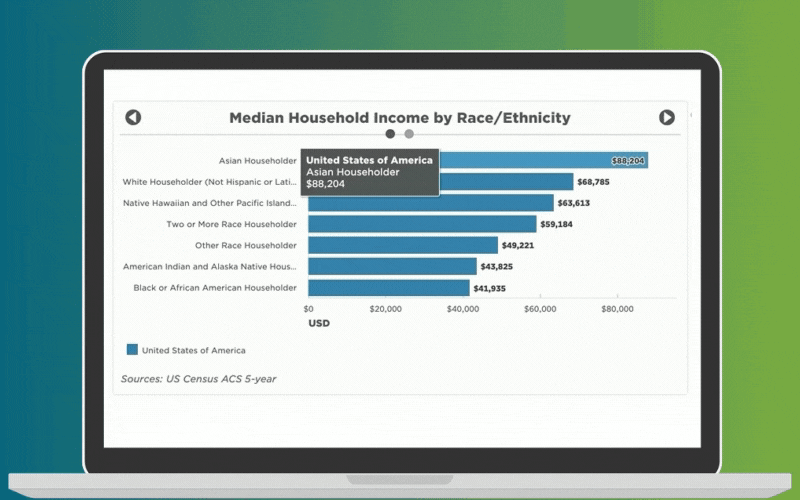10 City Data Questions Answered With the DataKC Team
You asked and they answered. The DataKC team at Kansas City, Missouri is at the heart of data-driven decision making. Their work is often reviewed by cities trying to decide what is possible when it comes to data and innovation so now they’re giving us the scoop. We sat down with Kate Bender and Julie Steenson from the DataKC team to give you an inside look at how to use data like Kansas City.
Data and Culture
How do you get buy-in for data-driven management?
A foundational requirement is explicit leadership buy-in and advocacy. You need active engagement from your leaders who are pushing for this. When we got started that looked like the mayor and city manager setting aside time on their calendar on a monthly and weekly basis to review data.
From there, we’ve summed up the keys to data-driven management as being the “three R’s”:
Relevance - we reviewed the data with department staff to make sure what we were collecting was relevant to their operations. Relevance means working with the departments, listening, and hearing them out.
Repetition - once we had established some key metrics for departments we were bringing the data to them. Whether that's every six weeks, every month, or every week we were putting it in front of them. When everyone in City Hall sees the data and knows they can’t get around it, it helps to get more people get on board.
Residents - once we had good data and a routine forum for discussing it, we could use the data to tell compelling stories. When staff can tell a story to advocate for resources or to meaningfully demonstrate their situation to stakeholders, it commits them further to data-driven management.
Has the media ever used the data to write something damning or unexpected?
The approach set by our leadership was that we were not going to have a “gotcha” approach to data. It’s accountability, but it’s not about that kind of accountability. The gotcha stuff sounds interesting, but that style of management backfires over time and leads people to reject data as a tool.
Based on our approach to openly discussing data and problems, usually if a problem shows up in the survey or another dataset, people and the media are already aware of it. It isn’t really a surprise. Data is often just another point of reference or source the media can match up with an anecdotal story. Our approach to transparency makes it harder for other entities to play “gotcha” with us as well.
What do you do when new leadership comes in?
We have term limits, so we have at least a few new council people every four years. One useful tool for orienting new city council people to data is to customize reporting to their particular district. The mySidewalk resident survey dashboard has been really helpful for doing that.
We started really working on data in 2009, 2010. That was 2 mayors ago. Much of the work we’ve done was under Mayor Sly James who left office in July. Data and efficiency was part of his mayoral platform and he was a true champion for change in this area. Because of the commitment the city has made to data-driven management over the last decade, our new Mayor, Quinton Lucas, and the council members elected this term all see data as an established way of doing business. The data just shows up. It’s such an ever present thing now. Being a champion for data now means continuing to ask questions and elevate data stories, and continuing to integrate the established value of data-driven management into our operations and systems.
Resident Surveys
How did you get started with the resident satisfaction survey?
Our office took over survey administration as we started to form our team focused on supporting data-driven management. We had an existing version of the survey that had been happening for about ten years and the methodology and structure was really well-established. We saw an opportunity to establish the survey results as outcome measurements for city operations, and then integrate them into the performance management structure.
Did you face any challenges in using the survey in performance efforts?
Yes - at the time we took it over, many people had a strong dislike or distrust for the survey results. People were fixated on some of the questions in the survey. They felt like they weren’t relevant or reflective of their department’s operations. In order to get buy in from staff, we realized we needed to open up the survey for revisions, to ensure everyone thought it was collecting relevant information.
This is a value we’ve carried forward: survey questions are not sacred. There are a few that are mandatory, but you have to constantly review the survey and ask “does this have value?” If no one can demonstrate the value of the question, don’t keep it. Unused questions harm your buy-in with department staff and impact the likelihood that residents complete it.
How do you use the resident survey?
We use it to make data-oriented decisions. We rely on the prioritization element to provide feedback to departments about areas we should be emphasizing. If something is really important we will see residents saying so in the data. Our goal is to serve up a lot of useful data and allow leaders to engage with it. We also have to be ok with them not just making a decision based on data. Not every decision comports with the data exactly.
An example of using the data to make a huge decision was when we put a three General Obligation Bond questions on the ballot in 2017 to address infrastructure. We knew infrastructure needs had been a priority since we started the survey. The level of attention and consistency we were seeing from resident responses gave us confidence from City Hall that we could put a big bond issue out to deal with our infrastructure challenges and people would vote for it. We also structured the bond issue to focus on key areas that residents told us were important: streets, sidewalks, and stormwater management. The $800 million infrastructure repair plan (GO KC) passed with each section of the funding capturing more than 60 percent support.
Overall, the survey confirms our biases and assumptions so we can do something about the problems we have. We can show the data to elected officials and staff and prove that it isn’t just Angie and her personal experience on the street, it’s the pulse of the city. We can make a strong case for making investments in key areas using the voice of residents.
How do you prove the value or make the case to purchase the survey?
The resident satisfaction survey costs about what we would pay for an analyst position, but the value exceeds what any single person could produce. The value gets proven when we use the data to make a case for more resources or make a case for spending less because we see where we are overspending. It is not an easy ROI, it’s the long trajectory of understanding what your residents want that keeps you from just taking shots in the dark.
If you really leverage the data it’s more than worth it. When you spend $60-$70k for data you’re going to use across departments the ROI comes from embedding it in so many things and having so many uses. At this point it would be hard for people to imagine it going away because we use it for everything.
What do you do if your scores go down? Do you still report them?
A resounding yes. You have to be willing to report scores going down. Resident opinion will fluctuate whether you have a survey or not. It’s better to know and work on it than be blissfully unaware. If you’re in the third or fourth year of the survey get ready and know how to handle it, but with data now you can actually do something about the challenges you have.
We’ve presented a lot of bad data and no one has died yet. Our collaborative approach means that data is presented with context and there is an understanding that problems are multifaceted.
Tools you need
What type of resources are needed for a performance management program?
One of the most important resources you could have in performance management is a staff that is dedicated to data. This could just be one person or it could be a team of several people, but you need someone with data in their job description. You should be working with a lot of different departments but you need a central data champion. We started the program with one person and now we have 6 analysts. We’ve been growing slowly and incrementally.
The companion to that is visualization. We have continuously sought a better way to visualize which is why we started working with mySidewalk. Now we can go in and snip something really fast. We don’t need to make a pivot table or spend time in complicated software. The mySidewalk tool lets us visualize the data and get access everything very quickly. (Check out the Resident Satisfaction Dashboard)
We’ve been very Excel-oriented for analysis. We also use R, Python, and PowerBI to analyze the data for our internal audience. We get the visualization and storytelling in the mySidewalk platform.
Any advice for other organizations trying to pursue performance management?
-
A core value of our shop is iteration and that’s something we embed in all our projects and we teach and preach to our staff. We’re constantly iterating on what we can do better and evolving our projects and efforts forward to make them better.
-
Collectively you have to talk about strengths and weaknesses. Transparency is so important.
-
Celebrate your success.
Kansas City is a leader and role model both for cities and for those of us in the civic tech space working to understand how cities use data and how we can help support them. The DataKC team didn’t develop their success overnight. Over the years they have worked with their leadership, their staff, and their data to create a data culture that has helped them inform city decisions. Data-driven decision making is possible and at the end of the day it’s all about cultivating a culture that supports and believes data.
Read more about Kansas City and their data story with mySidewalk here.
Share this
You May Also Like
These Related Stories

5 Eye-opening Data Lessons after a Year of Sheltering at Home

CHR&R in Flux: Our Commitment to Public Health Data


No Comments Yet
Let us know what you think